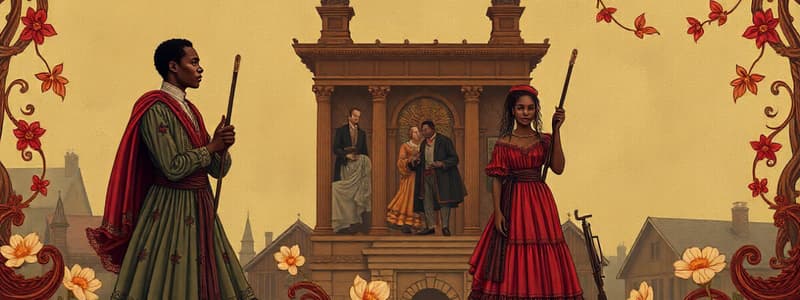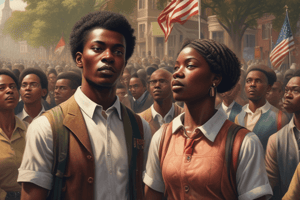Podcast
Questions and Answers
Which of the following best describes the goal of the "Redeemer Democrats" following the Reconstruction era?
Which of the following best describes the goal of the "Redeemer Democrats" following the Reconstruction era?
- To establish a biracial government that equally represented the interests of Black and White citizens.
- To foster reconciliation between the North and South by advocating for compromise on issues of civil rights.
- To modernize the Southern economy by promoting industrial growth and diversifying agriculture.
- To restore the antebellum social order by disenfranchising Black voters and upholding White supremacy. (correct)
How did the Supreme Court's ruling in Plessy v. Ferguson (1896) impact the rights of African Americans?
How did the Supreme Court's ruling in Plessy v. Ferguson (1896) impact the rights of African Americans?
- It established the "separate but equal" doctrine, upholding the constitutionality of segregation. (correct)
- It affirmed the right to vote for all male citizens, regardless of race, as guaranteed by the 15th Amendment.
- It overturned Jim Crow laws and mandated the integration of public facilities.
- It strengthened the 14th Amendment's equal protection clause, leading to greater racial equality.
How did the Compromise of 1877 effectively contribute to the end of Reconstruction?
How did the Compromise of 1877 effectively contribute to the end of Reconstruction?
- By impeaching key political figures, such as President Rutherford B. Hayes.
- By withdrawing federal troops from the South, thus diminishing the enforcement of Reconstruction policies. (correct)
- By allocating more funding to Reconstruction efforts to rebuild Southern infrastructure.
- By ensuring federal protection of Black voting rights in the South.
What distinguished the "Radical Republicans" approach to Reconstruction from that of more moderate factions?
What distinguished the "Radical Republicans" approach to Reconstruction from that of more moderate factions?
Which of the following describes the purpose and impact of the "Black Codes" enacted in Southern states after the Civil War?
Which of the following describes the purpose and impact of the "Black Codes" enacted in Southern states after the Civil War?
Flashcards
Redeemer Democrats
Redeemer Democrats
Southern Democrats who aimed to regain political power and white supremacy during Reconstruction.
Jim Crow Laws
Jim Crow Laws
State and local laws enforcing racial segregation in the Southern United States.
Ku Klux Klan (Original)
Ku Klux Klan (Original)
A white supremacist terrorist group that used violence and intimidation to suppress Black Americans after the war.
Black Codes
Black Codes
Signup and view all the flashcards
Plessy v. Ferguson
Plessy v. Ferguson
Signup and view all the flashcards
Study Notes
- Reconstruction began after the Confederacy's defeat, with the North imposing its will on the South, leading to political and economic oppression of white Southerners.
- White Southerners retaliated with laws and organizations targeting the rights and security of blacks, re-establishing a white elite and racial divisions.
Redeemer Democrats
- Primarily formed after the 15th Amendment to end Republican control, comprising all-white "conservative" parties that diminished Republican control in the South during the 1870s.
- They fought against the civil rights movement, believing they were saving the South from black rule and often rigged state elections for Democratic nominees.
- Tennessee and Virginia first established Democratic rule in 1869, and by 1876, nearly all states had redeemer governments comprised of white elites and Confederate leaders.
Jim Crow Laws
- Separate but equal laws, known as Jim Crow Laws, began in 1877, named after the African American song and dance "Jump Jim Crow" as a result of the Compromise of 1877.
- Opened up new economic opportunities for African-Americans, who formed their own economic and social groups.
- Poll taxes, grandfather clauses, literacy tests, and residency requirements were examples of these restrictions, making voting nearly impossible for blacks and poor whites, restoring the old southern elite to power.
Ku Klux Klan (The Original)
- Originally a club for Confederate veterans (social club) that opposed republicans, founded in Pulaski, Tennessee, in 1866.
- Formed due to the second (militarized) phase of Reconstruction to address their grievances, becoming a violent terrorist group to terrify and threaten former slaves and white republicans to prevent them from voting.
- Destroyed by President Grant in 1869 after becoming president in the 1866 election
- After the KKK was destroyed, the south started to obey reconstruction.
Black Codes
- Laws passed by state and local governments to limit the rights of former slaves; allowed cities to ban former slaves from buying land or starting city businesses.
- Enacted by former Confederate leaders who were re-elected, leading to increased racial division.
- Led to southerners having a harder time being seated in congress.
- Black Codes was created after the 13th amendment in 1865
- Led to the 14th amendment in 1868.
- Lincoln's original plan for Reconstruction was removed, and Radical Reconstruction was implemented, dividing the South into military districts and causing violence and terror.
Plessy V. Ferguson
- Occurred in 1896.
- Legalized Segregation, ruling separate but equal facilities as constitutional and stating that state-mandated segregation laws did not violate the 14th Amendment.
Compromise of 1877
- Ended Military Reconstruction after Hayes became president because the South was deemed peaceful.
- The election was tied between Rutherford B. Hayes and Samuel Tilden and was resolved with the compromise of 1877.
- Removed restrictions on voting for white southerners and secured the power of Redeemer Democrats.
- Hayes used the prospect of the end of reconstruction to get southern democrat voters on his side
- Democrats seized control in the South, passing Jim Crow Laws, with the withdrawal of military control.
15th Amendment
- Granted voting rights to all males, including blacks, but not females.
- Directly opposed the KKK's goal of limiting black votes; was regarded as retaliation from the North against the KKK.
14th Amendment
- Guaranteed citizenship to black people and immigrants born in the United States.
- Prohibited neglecting the rights of black or white citizens and ensured due process of law for all citizens.
- Was retaliation to forced labor of blacks through southern law and passed in 1868.
13th Amendment
- All re-added states had to ratify this as one of Lincoln's stipulations.
- Abolished slavery throughout the United States, leading the South to find other forced labor methods and ways to arrest blacks, such as for not having identification.
- Directly led to black codes.
Timeline of events
- 1865: End of Civil War
- 1865: 13th Amendment (frees slaves)
- 1865: Black Codes/Confederate Reaction
- 1866: Race Riots/Protests
- 1866: Ku Klux Klan
- 1867: Punitive Reconstruction/Reconstruction Acts (military districts)
- 1868: Johnson Impeachment Trial
- 1868: 14th Amendment (equal legal protection)
- 1868: Ulysses S. Grant is elected and crushes the KKK
- 1869-1876: Beginning, Growth, and Domination of redeemer democrats.
- 1870: 15th Amendment (All Males can Vote)
- 1877: Hayes is elected, reconstruction ends and troops withdraw.
- <1877: Jim Crow laws put into place.
Radical Regimes
- Moderate: Lincoln and Andrew Johnson supported moderate reconstruction.
- After Lincoln's assassination, Andrew Johnson became president but was impeached due to his moderate approach, leading to the era of radical republicans and military control.
- Radical: Favored military reconstruction and aimed to punish the South, contributing to the KKK and Jim Crow laws.
- Vagrancy laws were enacted to put blacks back onto plantations.
Studying That Suits You
Use AI to generate personalized quizzes and flashcards to suit your learning preferences.




